 Dodge Nitro: Occupant restraints
Dodge Nitro: Occupant restraints
Some of the most important safety features in your
vehicle are the restraint systems:
• Three-point lap and shoulder belts for all seating
positions.
• Advanced Front Airbags for driver and front passenger.
• Supplemental Active Head Restraints (AHR) located
on top of the front seats (integrated into the head
restraint).
• Supplemental Side Airbag Inflatable Curtains (SABIC)
for the driver and passengers seated next to a window.
• An energy-absorbing steering column and steering
wheel.
• Knee bolsters/blockers for front seat occupants.
• Front seat belts incorporate pretensioners to enhance
occupant protection by managing occupant energy
during an impact event.
• All seat belt systems (except the driver’s and rear
center) include Automatic Locking Retractors (ALRs),
which lock the seat belt webbing into position by
extending the belt all the way out and then adjusting
the belt to the desired length to restrain a child seat or
secure a large item in a seat.
If you will be carrying children too small for adult-sized
seat belts, the seat belts or the Lower Anchors and Tether
for CHildren (LATCH) feature also can be used to hold
infant and child restraint systems. For more information
on LATCH, see Lower Anchors and Tether for CHildren
(LATCH).
NOTE: The Advanced Front Airbags have a multistage inflator design. This allows the airbag to have different rates of inflation based on the severity and type of collision.
Please pay close attention to the information in this section. It tells you how to use your restraint system properly, to keep you and your passengers as safe as possible.
WARNING: In a collision, you and your passengers can suffer much greater injuries if you are not properly buckled up. You can strike the interior of your vehicle or other passengers, or you can be thrown out of the vehicle. Always be sure you and others in your vehicle are buckled up properly.
Buckle up even though you are an excellent driver, even on short trips. Someone on the road may be a poor driver and cause a collision that includes you. This can happen far away from home or on your own street. Research has shown that seat belts save lives, and they can reduce the seriousness of injuries in a collision. Some of the worst injuries happen when people are thrown from the vehicle. Seat belts reduce the possibility of ejection and the risk of injury caused by striking the inside of the vehicle. Everyone in a motor vehicle should be belted at all times.
Lap/Shoulder Belts
All seating positions in your vehicle are equipped with lap/shoulder belts. The belt webbing retractor is designed to lock during very sudden stops or collisions. This feature allows the shoulder part of the belt to move freely with you under normal conditions. However, in a collision the belt will lock and reduce the risk of you striking the inside of the vehicle or being thrown out.
WARNING:
• It is dangerous to ride in a cargo area, inside or
outside of a vehicle. In a collision, people riding in
these areas are more likely to be seriously injured
or killed.
• Do not allow people to ride in any area of your
vehicle that is not equipped with seats and seat
belts.
• Be sure everyone in your vehicle is in a seat and
using a seat belt properly.
• Wearing a seat belt incorrectly is dangerous. Seat
belts are designed to go around the large bones of
your body. These are the strongest parts of your
body and can take the forces of a collision the best.
Wearing your belt in the wrong place could make
your injuries in a collision much worse. You might
suffer internal injuries, or you could even slide out
of part of the belt. Follow these instructions to
wear your seat belt safely and to keep your passengers
safe too.
• Two people should never be belted into a single
seat belt. People belted together can crash into one
another in a collision, hurting one another badly.
Never use a lap/shoulder belt or a lap belt for more
than one person, no matter what their size.
Lap/Shoulder Belt Operating Instructions
1. Enter the vehicle and close the door. Sit back and adjust the seat. 2. The seat belt latch plate is located on the B-Pillar along the outboard side and rear of the seat cushion. The rear seat belt latch plates are located on the C-Pillar for the outboard rear seating positions and next to your arm in the center rear seating position. Grasp the latch plate and pull out the belt. Slide the latch plate up the webbing as far as necessary to make the belt go around your lap.
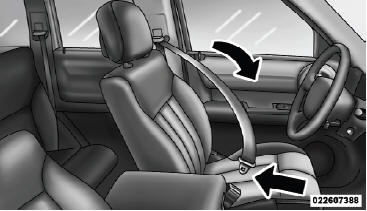 Latch Plate
Latch Plate
3. When the belt is long enough to fit, insert the latch plate into the buckle until you hear a “click.”
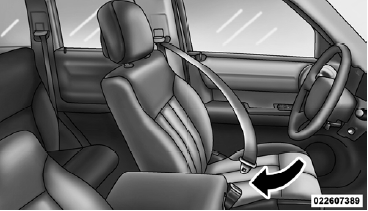 Latch Plate To Buckle
Latch Plate To Buckle
WARNING:
• A belt that is buckled into the wrong buckle will
not protect you properly. The lap portion could
ride too high on your body, possibly causing
internal injuries. Always buckle your belt into the
buckle nearest you.
• A belt that is too loose will not protect you
properly. In a sudden stop you could move too far
forward, increasing the possibility of injury. Wear
your seat belt snugly.
• A belt that is worn under your arm is dangerous.
Your body could strike the inside surfaces of the
vehicle in a collision, increasing head and neck
injury. A belt worn under the arm can cause
internal injuries. Ribs aren’t as strong as shoulder
bones. Wear the belt over your shoulder so that
your strongest bones will take the force in a
collision.
• A shoulder belt placed behind you will not protect
you from injury during a collision. You are more
likely to hit your head in a collision if you do not
wear your shoulder belt. The lap and shoulder belt
are meant to be used together.
4. Position the lap belt across your thighs, below your abdomen. To remove slack in the lap portion, pull up a bit on the shoulder belt. To loosen the lap belt if it is too tight, tilt the latch plate and pull on the lap belt. A snug belt reduces the risk of sliding under the belt in a collision.
WARNING:
• A lap belt worn too high can increase the risk of
injury in a collision. The belt forces won’t be at the
strong hip and pelvic bones, but across your abdomen.
Always wear the lap part of your seat belt
as low as possible and keep it snug.
• A twisted belt will not protect you properly. In a
collision, it could even cut into you. Be sure the
belt is straight. If you can’t straighten a belt in
your vehicle, take it to your authorized dealer
immediately and have it fixed.
5. Position the shoulder belt on your chest so that it is comfortable and not resting on your neck. The retractor will withdraw any slack in the belt.
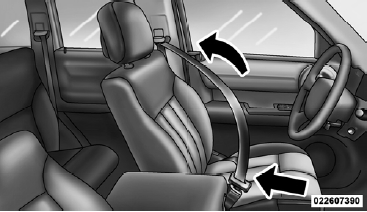 Removing Slack From Belt
Removing Slack From Belt
6. To release the belt, push the red button on the buckle. The belt will automatically retract to its stowed position. If necessary, slide the latch plate down the webbing to allow it to retract fully.
WARNING: A frayed or torn belt could rip apart in a collision and leave you with no protection. Inspect the belt system periodically, checking for cuts, frays, or loose parts. Damaged parts must be replaced immediately. Do not disassemble or modify the system. Seat belt assemblies must be replaced after a collision if they have been damaged (bent retractor, torn webbing, etc.).
Lap/Shoulder Belt Untwisting Procedure
Use the following procedure to untwist a twisted lap/ shoulder belt. 1. Position the latch plate as close as possible to the anchor point. 2. At about 6 to 12 in (15 to 30 cm) above the latch plate, grasp and twist the belt webbing 180 degrees to create a fold that begins immediately above the latch plate. 3. Slide the latch plate upward over the folded webbing. The folded webbing must enter the slot at the top of the latch plate. 4. Continue to slide the latch plate up until it clears the folded webbing.
Seat Belt Pretensioner
The seat belts for both front seating positions are equipped with a pretensioning device that is designed to remove any slack from the seat belt systems in the event of a collision. These devices improve the performance of the seat belt by assuring that the belt is tight around the occupant early in a collision. Pretensioners work for all size occupants, including those in child restraints.
NOTE: These devices are not a substitute for proper seat belt placement by the occupant. The seat belt must still be worn snugly and positioned properly The pretensioners are triggered by the Occupant Restraint Controller (ORC). Like the airbags, the pretensioners are single use items. A deployed pretensioner or a deployed airbag must be replaced immediately.
Adjustable Upper Shoulder Belt Anchorage
In the front seating positions, the shoulder belt can be adjusted upward or downward to position the belt away from your neck. Press the release button to release the anchorage, and then move it up or down to the position that fits you best.
NOTE: The adjustable upper shoulder belt anchorage is equipped with an Easy Up feature. This feature allows the shoulder belt anchorage to be adjusted in the upward position without pressing the release button. To verify the shoulder belt anchorage is latched, pull downward on the shoulder belt anchorage until it is locked into position.
 Adjusting Upper Shoulder Belt
Adjusting Upper Shoulder Belt
As a guide, if you are shorter than average, you will prefer a lower position, and if you are taller than average, you will prefer a higher position.
Seat Belts In Passenger Seating Positions
The seat belts in the passenger seating positions are equipped with Automatic Locking Retractors (ALR) which are used to secure a child restraint system. For additional information refer to “Installing Child Restraints Using the Vehicle Seat Belt” under the “Child Restraints” section. The chart below defines the type of feature for each seating position.

If the passenger seating position is equipped with an ALR and is being used for normal usage: Only pull the belt webbing out far enough to comfortably wrap around the occupants mid-section so as to not activate the ALR. If the ALR is activated you will hear a ratcheting sound as the belt retracts. Allow the webbing to retract completely in this case and then carefully pull out only the amount of webbing necessary to comfortably wrap around the occupants mid-section. Slide the latch plate into the buckle until you hear a click.
Automatic Locking Retractors (ALR) Mode
In this mode, the shoulder belt is automatically prelocked. The belt will still retract to remove any slack in the shoulder belt.
When To Use The Automatic Locking Mode
Use the Automatic Locking Mode anytime a child safety seat is installed in a seating position that has a belt with this feature. Children 12 years old and under should always be properly restrained in the rear seat.
How To Engage The Automatic Locking Mode
1. Buckle the combination lap and shoulder belt. 2. Grasp the shoulder portion and pull downward until the entire belt is extracted. 3. Allow the belt to retract. As the belt retracts, you will hear a clicking sound. This indicates the safety belt is now in the Automatic Locking Mode.
How To Disengage The Automatic Locking Mode
Unbuckle the combination lap/shoulder belt and allow it to retract completely to disengage the Automatic Locking Mode and activate the vehicle sensitive (emergency) locking mode.
Unbuckle the combination lap/shoulder belt and allow it to retract completely to disengage the Automatic Locking Mode and activate the vehicle sensitive (emergency) locking mode.
Supplemental Active Head Restraints (AHR)
These head restraints are passive, deployable components, and vehicles with this equipment cannot be readily identified by any markings, only through visual inspection of the head restraint. The head restraint will be split in two halves, with the front half being soft foam and trim, the back half being decorative plastic.
How the Active Head Restraints (AHR) Work
The Occupant Restraint Controller (ORC) determines whether the severity, or type of rear impact will require the Active Head Restraints (AHR) to deploy. If a rear impact requires deployment, both the driver and front passenger seat AHRs will be deployed. When AHRs deploy during a rear impact, the front half of the head restraint extends forward to minimize the gap between the back of the occupant’s head and the AHR. This system is designed to help prevent or reduce the extent of injuries to the driver and front passenger in certain types of rear impacts.
NOTE: The Active Head Restraints (AHR) may or may not deploy in the event of a front or side impact. However if during a front impact, a secondary rear impact occurs, the AHR may deploy based on the severity and type of the impact.
 Active Head Restraint (AHR) Components
Active Head Restraint (AHR) Components
1 — Head Restraint Front Half (Soft Foam and Trim). 3 — Head Restraint Back Half (Decorative Plastic Rear Cover). 2 — Seatback. 4 — Head Restraint Guide Tubes.
CAUTION: All occupants, including the driver, should not operate a vehicle or sit in a vehicle’s seat until the head restraints are placed in their proper positions in order to minimize the risk of neck injury in the event of a collision.
NOTE: For more information on properly adjusting and positioning the head restraint, refer to “Adjusting Active Head Restraints” in “Understanding The Features Of Your Vehicle”.
Resetting Active Head Restraints (AHR)
If the Active Head Restraints are triggered in a collision, you must reset the head restraint on the driver’s and front passenger seat. You can recognize when the Active Head Restraint has been triggered by the fact that they have moved forward (as shown in step three of the resetting procedure).
1. Grasp the deployed AHR from the rear seat.
 Hand Positioning Points On AHR
Hand Positioning Points On AHR
2. Position the hands on the top of the deployed AHR at a comfortable position. 3. Pull down then rearward towards the rear of the vehicle then down to engage the locking mechanism.
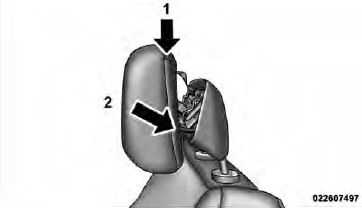
1 — Downward Movement. 2 — Rearward Movement.
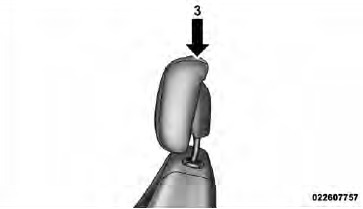
3 — Final Downward Movement To Engage Locking Mechanism
4. The AHR front soft foam and trim half should lock into the back decorative plastic half.
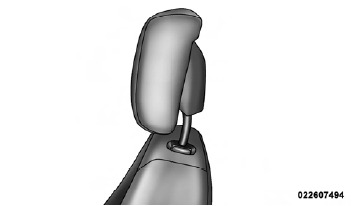 AHR In Reset Position
AHR In Reset Position
NOTE:
• If you have difficulties or problems resetting the
Active Head Restraints, see an authorized dealer.
• For safety reasons, have the Active Head Restraints
checked by a qualified specialist at an authorized
dealer.
Energy Management Feature
This vehicle has a safety belt system with an energy management feature in the front seating positions to help further reduce the risk of injury in the event of a head-on collision. This safety belt system has a retractor assembly that is designed to release webbing in a controlled manner. This feature is designed to help reduce the belt force acting on the occupant’s chest.
WARNING:
• The belt and retractor assembly must be replaced
if the seat belt assembly “Automatic Locking Retractor
(ALR)” feature or any other seat belt function
is not working properly when checked according
to the procedures in the Service Manual.
• Failure to replace the belt and retractor assembly
could increase the risk of injury in collisions.
Enhanced Seat Belt Use Reminder System (BeltAlert )
If the driver’s seat belt has not been buckled within 60 seconds of starting the vehicle and if the vehicle speed is greater than 5 mph (8 km/h), the BeltAlert will alert the driver to buckle the seat belt. The driver should also instruct all other occupants to buckle their seat belts. Once the warning is triggered, the BeltAlert will continue to chime and flash the Seat Belt Reminder Light for 96 seconds or until the driver’s seat belt is buckled. The BeltAlert will be reactivated if the driver’s seat belt is unbuckled for more than 10 seconds and the vehicle speed is greater than 5 mph (8 km/h).
BeltAlert can be enabled or disabled by your authorized dealer or by following these steps:
NOTE: The following steps must occur within the first 60 seconds of the ignition switch being turned to the ON or START position. The manufacturer does not recommend deactivating BeltAlert . 1. Turn the ignition switch to the OFF position, and fasten the driver seat belt. 2. Start the engine, and wait for the Seat Belt Reminder Light to turn off. 3. Within 60 seconds of starting the vehicle, unbuckle and then re-buckle the driver seat belt at least three times, ending with the seat belt buckled. 4. Turn OFF the engine. A single chime will sound to signify that you have successfully completed the programming. BeltAlert can be reactivated by repeating this procedure.
NOTE: Although BeltAlert has been deactivated, the Seat Belt Reminder Light will continue to illuminate while the driver seat belt remains unfastened.
Seat Belt Lock Out
The center rear seat belt system has a lock out feature that will not allow you to extract the center webbing unless the rear seat upper latch is engaged.
Seat Belts and Pregnant Women
We recommend that pregnant women use the seat belts throughout their pregnancy. Keeping the mother safe is the best way to keep the baby safe. Pregnant women should wear the lap part of the belt across the thighs and as snug across the hips as possible. Keep the belt low so that it does not come across the abdomen. That way the strong bones of the hips will take the force if there is a collision.
Seat Belt Extender
If a seat belt is too short even when fully extended and when the adjustable upper shoulder belt anchorage (if equipped) is in its lowest position, your authorized dealer can provide you with a seat belt extender. This extender should be used only if the existing belt is not long enough. When it is not required, remove the extender and store it.
WARNING: Using a seat belt extender when not needed can increase the risk of injury in a collision. Only use when the lap belt is not long enough when it is worn low and snug, and in the recommended seating positions. Remove and store the extender when not needed.
Supplemental Restraint System (SRS) — Airbags
This vehicle has Advanced Front Airbags for both the driver and front passenger as a supplement to the seat belt restraint systems. The driver’s Advanced Front Airbag is mounted in the steering wheel. The passenger’s Advanced Front Airbag is mounted in the instrument panel, above the glove compartment. The words SRS/ AIRBAG are embossed on the airbag covers.
NOTE: These airbags are certified to the new Federal regulations for Advanced Airbags.
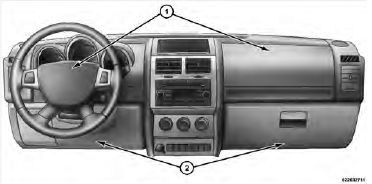 Front Airbag Components
Front Airbag Components
1 — Driver and Passenger Advanced Front Airbag. 2 — Knee Bolster.
The Advanced Front Airbags have a multistage inflator design. This allows the airbag to have different rates of inflation that are based on the severity and type of collision. This vehicle may be equipped with driver and/or front passenger seat track position sensors that may adjust the inflation rate of the Advanced Front Airbags based upon seat position. This vehicle may be equipped with a driver and/or front passenger seat belt buckle switch that detects whether the driver or front passenger seat belt is fastened. The seat belt buckle switch may adjust the inflation rate of the Advanced Front Airbags.
This vehicle is equipped with Supplemental Side Airbag Inflatable Curtains (SABIC) that run the entire length of the headliner to protect the driver, front, and rear passengers sitting next to a window.
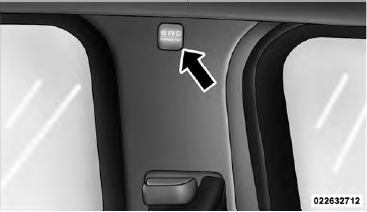 Supplemental Side Airbag Inflatable Curtains (SABIC)
Label Location
Supplemental Side Airbag Inflatable Curtains (SABIC)
Label Location
NOTE:
• Airbag covers may not be obvious in the interior trim;
but they will open during airbag deployment.
• After any collision, the vehicle should be taken to an
authorized dealer immediately.
Airbag System Components
Your vehicle may be equipped with the following airbag
system components:
• Occupant Restraint Controller (ORC).
• Airbag Warning Light.
• Steering Wheel and Column.
• Instrument Panel.
• Knee Impact Bolster.
• Driver Advanced Front Airbag.
• Passenger Advanced Front Airbag.
• Supplemental Side Airbag Inflatable Curtains (SABIC).
• Front and Side Impact Sensors.
• Front Seat Belt Pretensioners, Seat Belt Buckle Switch,
and Seat Track Position Sensors.
• Supplemental Active Head Restraint for Driver and
Front Passenger.
• Occupant Classification System (OCS).
• Occupant Classification Module (OCM).
• Passenger Airbag Disable (PAD) Indicator Light.
• Weight Sensors.
Advanced Front Airbag Features
The Advanced Front Airbag system has multistage driver and front passenger airbags. This system provides output appropriate to the severity and type of collision as determined by the Occupant Restraint Controller (ORC), which may receive information from the front impact sensors. The first stage inflator is triggered immediately during an impact that requires airbag deployment. The timing of the second stage determines whether the output force is low, medium, or high. If a low output is sufficient to meet the need, the remaining gas in the inflator is expended.
NOTE: The passenger Advanced Front Airbag may not deploy, even when the driver Advanced Front Airbag has, if the Occupant Classification System (refer to Occupant Classification System”) has determined the passenger seat is empty or is occupied by someone that is classified in the child size category. This could be a child, teenager, or even an adult.
WARNING:
• No objects should be placed over or near the
airbag on the instrument panel, because any such
objects could cause harm if the vehicle is in a
collision severe enough to cause the airbag to
inflate.
• Do not put anything on or around the Advanced
Front Airbag covers or attempt to manually open
them. You may damage the airbags and you could
be injured because the airbags may no longer be
functional. These protective covers for the airbag
cushions are designed to open only when the
airbags are inflating.
• Do not use accessory seat covers or place objects
between you and the side airbags; the performance
could be adversely affected and/or objects could
be pushed into you, causing serious injury.
• Do not drill, cut or tamper with the knee bolster in
any way.
• Do not mount any accessories to the knee bolster
such as alarm lights, stereos, citizen band radios,
etc.
• Do not have any accessory items installed which
will alter the roof, including adding a sunroof to
your vehicle. Do not add roof racks that require
permanent attachments (bolts or screws) for installation
on the vehicle roof. Do not drill into the roof
of the vehicle for any reason.
Supplemental Side Airbag Inflatable Curtain (SABIC)
SABIC airbags may offer side-impact and vehicle rollover protection to front and rear seat outboard occupants in addition to that provided by the body structure. Each airbag features inflated chambers placed adjacent to the head of each outboard occupant that reduce the potential for side-impact head injuries. The SABIC airbags deploy downward, covering both windows on the impact side.
NOTE:
• Should a vehicle rollover occur, the pretensioners
and/or SABIC airbags on both sides of the vehicle
may deploy.
• Airbag covers may not be obvious in the interior trim;
but they will open during airbag deployment.
The system includes side impact sensors adjacent to both
front and rear seat occupants that are calibrated to deploy
the SABIC airbags during impacts that require side
airbag occupant protection.
WARNING:
• If your vehicle is equipped with left and right
Supplemental Side Airbag Inflatable Curtain
(SABIC), do not stack luggage or other cargo up
high enough to block the location of the SABIC.
The area where the SABIC is located should remain
free from any obstructions.
• Do not use accessory seat covers or place objects
between you and the side airbags; the performance
could be adversely affected and/or objects could
be pushed into you, causing serious injury.
• If your vehicle is equipped with SABIC airbags,
do not have any accessory items installed which
will alter the roof, including adding a sunroof to
your vehicle. Do not add roof racks that require
permanent attachments (bolts or screws) for installation
on the vehicle roof. Do not drill into the roof
of the vehicle for any reason.
Knee Impact Bolsters
The Knee Impact Bolsters help protect the knees of the driver and the front passenger, and position front occupants for the best interaction with the Advanced Front Airbag. Along with seat belts and pretensioners, Advanced Front Airbags work with the knee bolsters to provide improved protection for the driver and front passenger. Side airbags also work with seat belts to improve occupant protection. Here are some simple steps you can take to minimize the risk of harm from a deploying airbag: 1. Children 12 years and younger should always ride buckled up in a rear seat.
WARNING: Infants in rear facing child restraints should NEVER ride in the front seat of a vehicle with a passenger airbag. An airbag deployment could cause severe injury or death to infants in that position.
Children that are not big enough to properly wear the vehicle seat belt should be secured in the rear seat, in a child restraint or belt-positioning booster seat. Older children who do not use child restraints or beltpositioning booster seats should ride properly buckled up in the rear seat. Never allow children to slide the shoulder belt behind them or under their arm.
If a child from 1 to 12 years old (not in a rear facing child seat) must ride in the front passenger seat, move the seat as far back as possible and use the proper child restraint. (Refer to “Child Restraints”) You should read the instructions provided with your child restraint to make sure that you are using it properly. 2. All occupants should ALWAYS wear their lap and shoulder belts properly. 3. The driver and front passenger seats should be moved back as far as practical to allow the Advanced Front Airbags room to inflate. 4. Do not lean against the door or window. If your vehicle has side airbags, and deployment occurs, the side airbags will inflate forcefully into the space between you and the door. 5. If the airbag system in this vehicle needs to be modified to accommodate a disabled person, contact the customer center. Phone numbers are provided under “If You Need Assistance”.
WARNING:
• Relying on the airbags alone could lead to more
severe injuries in a collision. The airbags work
with your seat belt to restrain you properly. In
some collisions, the airbags won’t deploy at all.
Always wear your seat belts even though you have
airbags.
• Being too close to the steering wheel or instrument
panel during Advanced Front Airbag deployment
could cause serious injury, including death. Airbags
need room to inflate. Sit back, comfortably
extending your arms to reach the steering wheel or
instrument panel.
• The Supplemental Side Airbag Inflatable Curtains
(SABIC) need room to inflate. Do not lean against
the door or window. Sit upright in the center of the
seat.
Airbag Deployment Sensors and Controls
Occupant Restraint Controller (ORC)
The ORC is part of a Federally regulated safety system required for this vehicle. The ORC determines if deployment of the front and/or side airbags in a frontal or side collision is required. Based on the impact sensors signals, a central electronic ORC deploys the Advanced Front Airbags, Supplemental Side Airbag Inflatable Curtain (SABIC), and front seat belt pretensioners, as required, depending on each type of impact. Advanced Front Airbags are designed to provide additional protection by supplementing the seat belts in certain frontal collisions depending on the severity and type of collision. Advanced Front Airbags are not expected to reduce the risk of injury in rear, side, or rollover collisions. The Advanced Front Airbags will not deploy in all frontal collisions, including some that may produce substantial vehicle damage — for example, some pole collisions, truck underrides, and angle offset collisions. On the other hand, depending on the type and location of impact, Advanced Front Airbags may deploy in crashes with little vehicle front-end damage but that produce a severe initial deceleration. The SABIC will not deploy in all side collisions. SABIC deployment will depend on the severity and type of collision. Because airbag sensors measure vehicle deceleration over time, vehicle speed and damage by themselves are not good indicators of whether or not an airbag should have deployed. Seat belts are necessary for your protection in all crashes, and also are needed to help keep you in position, away from an inflating airbag. The ORC also monitors the readiness of the electronic parts of the airbag system whenever the ignition switch is in the START or ON positions. If the key is in the LOCK position, in the ACC position, or not in the ignition, the airbag system is not on and the airbags will not inflate. The ORC contains a backup power supply system that may deploy the airbags even if the battery loses power or it becomes disconnected prior to deployment.
 Also, the ORC turns on the
“Airbag Warning
Light” for four to eight seconds for a self-check
when the ignition is first turned ON. After the
self-check, the “Airbag Warning Light” will
turn off. If the ORC detects a malfunction in any part of
the system, it turns on the “Airbag Warning Light” either
momentarily or continuously. A single chime will sound
if the light comes on again after initial startup.
It also includes diagnostics that will illuminate the instrument
cluster Airbag Warning Light if a malfunction is
noted that could affect the airbag system. The diagnostics
also record the nature of the malfunction.
Also, the ORC turns on the
“Airbag Warning
Light” for four to eight seconds for a self-check
when the ignition is first turned ON. After the
self-check, the “Airbag Warning Light” will
turn off. If the ORC detects a malfunction in any part of
the system, it turns on the “Airbag Warning Light” either
momentarily or continuously. A single chime will sound
if the light comes on again after initial startup.
It also includes diagnostics that will illuminate the instrument
cluster Airbag Warning Light if a malfunction is
noted that could affect the airbag system. The diagnostics
also record the nature of the malfunction.
WARNING: Ignoring the “Airbag Warning Light” in your instrument panel could mean you won’t have the airbags to protect you in a collision. If the light does not come on, stays on after you start the vehicle, or if it comes on as you drive, have an authorized dealer service the airbag system immediately.
Occupant Classification System (OCS)
The OCS is part of a Federally regulated safety system required for this vehicle. It is designed to turn off the passenger Advanced Front Airbag for an empty seat and for occupants classified in a category other than an adult. This could be a child, teenager, or even an adult.
NOTE: Children 12 years and younger should always ride buckled up in a rear seat in an appropriate child restraint.
• Occupant Classification System (OCS)
The OCS is part of a Federally regulated safety system required for this vehicle. It is designed to turn off the passenger Advanced Front Airbag for an empty seat and for occupants classified in a category other than an adult. This could be a child, teenager, or even an adult.
NOTE: Children 12 years and younger should always ride buckled up in a rear seat in an appropriate child restraint.
• Occupant Classification Module (OCM)
The OCM is located beneath the front passenger seat. The OCM classifies the occupant into categories based on the measurements made by the seat weight sensors. The OCM communicates with the ORC. The ORC uses the occupant category to determine whether the passenger Advanced Front Airbag should be turned off. It also determines the rate of airbag inflation during a collision.
• Weight Sensors
Your vehicle has fourWeight Sensors located between the seat and the floor pan. The weight sensors measure applied weight and transfers that information to the OCM.
• Passenger Airbag Disable (PAD) Indicator Light
The PAD Indicator Light (an amber light located in the center of the instrument panel) tells the driver and front passenger when the passenger Advanced Front Airbag is turned off. The PAD Indicator light illuminates the words “PASS AIR BAG OFF” to show that the passenger Advanced Front Airbag will not inflate during a collision requiring airbag deployment. When the right front passenger seat is empty or when very light objects are placed on the seat, the passenger airbag will not inflate even though the PAD indicator light is not illuminated.
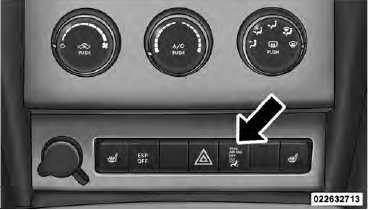 Indicator Light Location
Indicator Light Location
The PAD indicator light should not be illuminated when an adult passenger is properly seated in the front passenger seat. In this case, the passenger Advanced Front Airbag is ready to be inflated if a collision requires an airbag deployment.
For all other occupants, the PAD indicator light will be illuminated indicating that the passenger Advanced Front Airbag is turned off and will not inflate.
NOTE: Even though this vehicle is equipped with an occupant classification system, children 12 years and younger should always ride buckled up in a rear seat in an appropriate child restraint (refer to “Child Restraints”).
WARNING: Never place a rear facing infant seat in front of an airbag. A deploying passenger Advanced Front Airbag can cause death or serious injury to a child in a rear-facing infant seat.
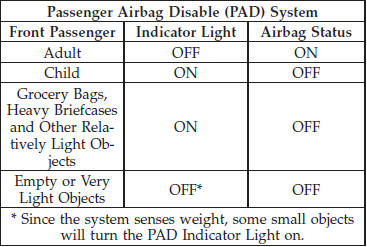
Drivers and adult passengers should verify that the PAD Indicator Light is not illuminated when an adult is riding in the front passenger seat. If an adult occupant’s weight is transferred to another part of the vehicle (like the door or instrument panel), the weight sensors in the seat may not properly classify the occupant. Objects lodged under the seat or between the seat and the center console can prevent the occupant’s weight from being measured properly and may result in the occupant being improperly classified. Ensure that the front passenger seatback does not touch anything placed on the second row of seats because this can also affect occupant classification. Also, if you fold down the seats in the second row check to be sure they don’t touch the front passenger seat. If the front passenger seat is damaged in any way, it should only be serviced by an authorized dealer. If the seat is removed (or even if the seat attachment bolts are loosened or tightened in any way), take the vehicle to an authorized dealer. If there is a fault present in the airbag system, the Airbag Warning Light (a red light located in the center of the instrument cluster directly in front of the driver) will be turned on. This indicates that you should have an authorized dealer service the system immediately. The Airbag Warning Light is turned on whenever there is a fault that can affect the operation of the airbag system. If there is a fault present in the PAD Indicator Light, the Airbag Warning Light will be illuminated to show that the passenger Advanced Front Airbag may be turned off until the fault is cleared. If the Airbag Warning Light is illuminated, have an authorized dealer service the airbag system immediately. If an object is lodged under the seat and interferes with operation of the weight sensors, a fault will occur which turns on both the PAD Indicator Light and the Airbag Warning Light. Once the lodged object is removed, the fault will be automatically cleared after a short period of time.
Driver and Passenger Advanced Front Airbag Inflator Units
The Driver and Passenger Advanced Front Airbag Inflator Units are located in the center of the steering wheel and the right side of the instrument panel. When the ORC detects a collision requiring the Advanced Front Airbags, it signals the inflator units. A large quantity of non-toxic gas is generated to inflate the Advanced Front Airbags. Different airbag inflation rates are possible based on collision severity and type. The steering wheel hub trim cover and the upper right side of the instrument panel separate and fold out of the way as the airbags inflate to their full size. The airbags fully inflate in about 50 to 70 milliseconds. This is about half of the time it takes to blink your eyes. The airbags then quickly deflate while helping to restrain the driver and front passenger. The Advanced Front Airbag gas is vented through the vent holes in the sides of the airbag. In this way, the airbags do not interfere with your control of the vehicle. Along with seat belts and pretensioners, Advanced Front Airbags work with the knee bolsters to provide improved protection for the driver and front passenger. Side airbags also work with seat belts to improve occupant protection.
Supplemental Side Airbag Inflatable Curtains (SABIC)
The Supplemental Side Airbag Inflatable Curtains (SABIC) may deploy during rollovers and collisions where the impact is confined to a particular area of the side of the vehicle, depending on the severity and type of collision. In these events, the ORC will deploy the SABIC only on the impact side of the vehicle. Because airbag sensors estimate deceleration over time, vehicle speed and damage by themselves are not good indicators of whether or not an airbag should have deployed.
Aquantity of non-toxic gas is generated to inflate the side curtain airbag. The inflating side curtain airbag pushes the outside edge of the headliner out of the way and covers the window. The airbag inflates in about 30 milliseconds (about one quarter of the time it takes to blink your eyes) with enough force to injure you if you are not belted and seated properly, or if items are positioned in the area where the side curtain airbag inflates. This especially applies to children. The side curtain airbag is only about 31⁄2 inches (9 cm) thick when it is inflated. The system includes side impact sensors adjacent to both front and rear seat occupants that are calibrated to deploy the SABIC airbags during impacts that require airbag occupant protection.
WARNING: If your vehicle is equipped with left and right Supplemental Side Airbag Inflatable Curtains (SABIC), do not stack luggage or other cargo up high enough to block the location of the SABIC. The area where the SABIC is located should remain free from any obstructions.
The front passenger seat assembly contains critical components that affect the front passenger airbag deployment. Correctly functioning front passenger seat components are critical for the Occupant Classification System (OCS) to properly classify the front passenger and calculate the proper airbag deployment. Do not make any modifications to the front passenger seat components, assembly, or to the seat cover.
The following requirements must be strictly adhered to:
• Do not modify the front passenger seat assembly or
components in any way.
• Do not use prior or future model year seat covers not
designated for the specific model being repaired. Always
use the correct seat cover specified for the
vehicle.
• Do not replace the seat cover with an aftermarket seat
cover.
• Do not add a secondary seat cover other than those
approved by Chrysler Group LLC/Mopar .
• At no time should any Supplemental Restraint System
(SRS) component or SRS related component or fastener
be modified or replaced with any part except
those which are approved by Chrysler Group
LLC/Mopar .
WARNING: Unapproved modifications or service procedures to the front passenger seat assembly, its related components or seat cover may inadvertently change the airbag deployment in case of a frontal crash. This could result in death or serious injury to the front seat passenger if the vehicle is involved in a collision. A modified vehicle may not comply with required Federal Motor Vehicle Safety Standards (FMVSS) and/or Canadian Motor Vehicle Safety Standards (CMVSS).
Enhanced Accident Response System
In the event of an impact causing airbag deployment, if
the communication network remains intact, and the
power remains intact, depending on the nature of the
event the ORC will determine whether to have the
Enhanced Accident Response System perform the following
functions:
• Cut off fuel to the engine.
• Flash hazard lights as long as the battery has power or
until the ignition key is turned off.
• Turn on the interior lights, which remain on as long as
the battery has power or until the ignition key is
removed.
• Unlock the doors automatically.
If a Deployment Occurs
The front airbags are designed to deflate immediately after deployment.
NOTE: Front and/or side airbags will not deploy in all
collisions. This does not mean something is wrong with
the airbag system.
If you do have a collision which deploys the airbags, any
or all of the following may occur:
• The nylon airbag material may sometimes cause abrasions
and/or skin reddening to the driver and front
passenger as the airbags deploy and unfold. The
abrasions are similar to friction rope burns or those
you might get sliding along a carpet or gymnasium
floor. They are not caused by contact with chemicals.
They are not permanent and normally heal quickly.
However, if you haven’t healed significantly within a
few days, or if you have any blistering, see your doctor
immediately.
• As the airbags deflate you may see some smoke-like
particles. The particles are a normal by-product of the
process that generates the non-toxic gas used for
airbag inflation. These airborne particles may irritate
the skin, eyes, nose, or throat. If you have skin or eye
irritation, rinse the area with cool water. For nose or
throat irritation, move to fresh air. If the irritation
continues, see your doctor. If these particles settle on
your clothing, follow the garment manufacturer’s instructions
for cleaning.
Do not drive your vehicle after the airbags have deployed.
If you are involved in another collision, the
airbags will not be in place to protect you.
WARNING: Deployed airbags cannot protect you in another collision. Have the airbags, and seat belt retractor assembly replaced by an authorized dealer as soon as possible.
Maintaining Your Airbag System
WARNING:
• Modifications to any part of the airbag system
could cause it to fail when you need it. You could
be injured if the airbag system is not there to
protect you. Do not modify the components or
wiring, including adding any kind of badges or
stickers to the steering wheel hub trim cover or the
upper right side of the instrument panel or the
headliner along the side rails. Do not modify the
front bumper or vehicle body structure.
• Do not attempt to modify any part of your advanced
airbag system. The airbag may inflate
accidentally or may not function properly if modifications
are made. Take your vehicle to an authorized
dealer for any advanced airbag system service.
If it is necessary to modify the airbag system
for persons with disabilities, contact your authorized
dealer.
• It is dangerous to try to repair any part of the
airbag system yourself. Be sure to tell anyone who
works on your vehicle that it has an airbag system.
Airbag Warning Light
You will want to have the airbag system ready to inflate
for your protection in an impact. The airbag warning
light monitors the internal circuits and interconnecting
wiring associated with airbag system electrical components.
The airbag system is designed to be maintenance
free. If any of the following occurs, have an authorized
dealer service the system promptly:
• Does not come on during the four to eight seconds
after the ignition switch is first turned ON.
• Remains on after the four to eight second interval.
• Comes on for any period of time while driving.
Event Data Recorder (EDR)
In the event of a collision, your vehicle is designed to record up to five seconds of specific vehicle data parameters (see list below) in an event data recorder prior to the moment of airbag deployment, or near deployment (if applicable), and up to a quarter second of either highspeed deceleration data or change in velocity during and/or after airbag deployment or near-deployment. EDR data is ONLY recorded if an airbag deploys, or nearly deploys, and is otherwise unavailable.
NOTE:
1. A near-deployment event occurs when the airbag
sensor detects severe vehicle deceleration usually indicative
of a crash, but not severe enough to warrant airbag
deployment.
2. Under certain circumstances, EDR data may not be
recorded (e.g., loss of battery power).
In conjunction with other data gathered during a complete
accident investigation, the electronic data may be
used by Chrysler Group LLC and others to learn more
about the possible causes of crashes and associated
injuries in order to assess and improve vehicle performance.
In addition to crash investigations initiated byChrysler Group LLC, such
investigations may be requested
by customers, insurance carriers, government
officials, and professional crash researchers, such as those
associated with universities, and with hospital and insurance
organizations.
In the event that an investigation is undertaken by
Chrysler Group LLC (regardless of initiative), the company
or its designated representative will first obtain
permission of the appropriate custodial entity for the
vehicle (usually the vehicle owner or lessee) before
accessing the electronic data stored, unless ordered to
image the data by a court with legal jurisdiction (i.e.,
pursuant to a warrant). A copy of the data will be
provided to the custodial entity upon request. General
data that does not identify particular vehicles or crashes
may be released for incorporation in aggregate crash
databases, such as those maintained by the U.S. government
and various states. Data of a potentially sensitive
nature, such as would identify a particular driver, vehicle,
or crash, will be treated confidentially. Confidential
data will not be disclosed by Chrysler Group LLC to any
third party except when:
1. Used for research purposes, such as to match data
with a particular crash record in an aggregate database,
provided confidentiality of personal data is thereafter
preserved.
2. Used in defense of litigation involving a Chrysler
Group LLC product.
3. Requested by police under a legal warrant.
4. Otherwise required by law.
Data parameters that are recorded:
• Diagnostic trouble code(s) and warning light status for
electronically-controlled safety systems, including the
airbag system.
• Vehicle speed.
• Engine RPM.
• Brake switch status.
• Pedal position.
• And other parameters depending on vehicle
configuration.
Child Restraints
Everyone in your vehicle needs to be buckled up all the time including babies and children. Every state in the United States and all Canadian provinces require that small children ride in proper restraint systems. This is the law, and you can be prosecuted for ignoring it. Children 12 years and younger should ride properly buckled up in a rear seat, if available. According to crash statistics, children are safer when properly restrained in the rear seats rather than in the front. There are different sizes and types of restraints for children from newborn size to the child almost large enough for an adult safety belt. Always check the child seat Owner’s Manual to ensure you have the right seat for your child. Use the restraint that is correct for your child.
WARNING: In a collision, an unrestrained child, even a tiny baby, can become a projectile inside the vehicle. The force required to hold even an infant on your lap can become so great that you could not hold the child, no matter how strong you are. The child and others could be badly injured. Any child riding in your vehicle should be in a proper restraint for the child’s size.
Infants and Child Restraints
• Safety experts recommend that children ride
rearward-facing in the vehicle until they are at least
one year old and weigh at least 20 lbs (9 kg). Two types
of child restraints can be used: rearward-facing infant
carriers and “convertible” child seats.
• The infant carrier is only used rearward-facing in the
vehicle. It is recommended for children who weigh up
to about 20 lbs (9 kg). “Convertible” child seats often
have a higher weight limit in the rearward-facing
direction than infant carriers do, so they can be used
rearward-facing by children who weigh more than
20 lbs (9 kg) but are less than one year old. Both types
of child restraints are held in the vehicle by the
lap/shoulder belt or the LATCH child restraint anchorage
system (Refer to LATCH — Child Seat Anchorage
System.)
• Rearward-facing child seats must NEVER be used in
the front seat of a vehicle with the front passenger
airbag unless the airbag is turned off. An airbag
deployment could cause severe injury or death to
infants in this position.
WARNING:
• Improper installation can lead to failure of an
infant or child restraint. It could come loose in a
collision. The child could be badly injured or
killed. Follow the manufacturer’s directions exactly
when installing an infant or child restraint.
• A rearward-facing infant restraint should only be
used in a rear seat. A rearward-facing infant restraint
in the front seat may be struck by a deploying
passenger airbag which may cause severe or
fatal injury to the infant.
Here are some tips for getting the most out of your child
restraint:
• Before buying any restraint system, make sure that it
has a label certifying that it meets all applicable safety
standards. Chrysler Group LLC also recommends that
you try a child restraint in the vehicle seats where you
will use it before you buy it.
• The restraint must be appropriate for your child’s
weight and height. Check the label on the restraint for
weight and height limits.
• Carefully follow the instructions that come with the
restraint. If you install the restraint improperly, it may
not work when you need it.
• Except for the second row center seating position, all
passenger seat belts are equipped with “automatic
locking retractors.” The second row center position
has a cinching latch plate. Both types of seat belts are
designed to keep the lap portion tight around the child
restraint so that it is not necessary to use a locking clip.
If the seat belt has a cinching latch plate, pulling up on
the shoulder portion of the lap/shoulder belt will
tighten the belt (the cinching latch plate will keep the
belt tight). However, any seat belt system may loosen
with time, so check the belt occasionally and pull it
tight if necessary. For the second row seat belts with
the automatic locking retractors, pull the belt from the
retractor until there is enough to allow it to pass
through the child restraint and slide the latch plate
into the buckle. Then, pull the belt until it is fully
extracted from the retractor. Allow the belt to return to
the retractor, pulling on the excess webbing to tighten
the lap portion around the child restraint. For additional
information, refer to Automatic Locking
Mode .
• In the rear seat, you may have trouble tightening the
lap/shoulder belt on the child restraint because the
buckle or latch plate is too close to the belt path
opening on the restraint. Disconnect the latch plate
from the buckle and twist the short buckle-end belt
several times to shorten it. Insert the latch plate into
the buckle with the release button facing out.
• If the belt still cannot be tightened, or if pulling and
pushing on the restraint loosens the belt, disconnect
the latch plate from the buckle, turn the buckle
around, and insert the latch plate into the buckle
again. If you still cannot make the child restraint
secure, try a different seating position.
• Buckle the child into the restraint exactly as the
manufacturer’s instructions tell you.
• When your child restraint is not in use, secure it in the
vehicle with the seat belt or remove it from the vehicle.
Do not leave it loose in the vehicle. In a sudden stop or
collision, it could strike the occupants or seatbacks and
cause serious personal injury.
NOTE: For additional information, refer to www.seatcheck.org or call 1–866–SEATCHECK. Canadian residents, should refer to Transport Canada’s website for additional information. http://www.tc.gc.ca/roadsafety/safedrivers/childsafety/index.htm
Older Children and Child Restraints
Children who weigh more than 20 lbs (9 kg) and who are older than one year can ride forward-facing in the vehicle. Forward-facing child seats and convertible child seats used in the forward-facing direction are for children who weigh 20 to 40 lbs (9 to 18 kg), and who are older than one year. These child seats are also held in the vehicle by the lap/shoulder belt or the LATCH child restraint anchorage system (refer to LATCH—Child Seat Anchorage System.) The belt-positioning booster seat is for children weighing more than 40 lbs (18 kg), but who are still too small to fit the vehicle’s seat belts properly. If the child cannot sit with knees bent over the vehicle’s seat cushion while the child’s back is against the seatback, they should use a belt-positioning booster seat. The child and beltpositioning booster seat are held in the vehicle by the lap/shoulder belt.
Children Too Large for Booster Seats
Children who are large enough to wear the shoulder belt
comfortably and whose legs are long enough to bend
over the front of the seat when their back is against the
seatback, should use the lap/shoulder belt in a rear seat.
• Make sure that the child is upright in the seat.
• The lap portion should be low on the hips and as snug
as possible.
• Check belt fit periodically. A child’s squirming or
slouching can move the belt out of position.
• If the shoulder belt contacts the face or neck, move the
child closer to the center of the vehicle. Never allow a
child to put the shoulder belt under an arm or behind
their back.
LATCH — Child Seat Anchorage System (Lower Anchors and Tether for CHildren)
Your vehicle’s rear seat is equipped with the child restraint anchorage system called LATCH. The LATCH system provides for the installation of the child restraint without using the vehicle’s seat belts, instead securing the child restraint using lower anchorages and upper tether straps from the child restraint to the vehicle structure. LATCH-compatible child restraint systems are now available. However, because the lower anchorages are to be introduced over a period of years, child restraint systems having attachments for those anchorages will continue to also have features for installation using the vehicle’s seat belts. Child restraints having tether straps and hooks for connection to the top tether anchorages, have been available for some time. For some older child restraints, many child restraint manufacturers offer add-on tether strap kits or retro-fit kits. You are urged to take advantage of all the available attachments provided with your child restraint in any vehicle. All three rear seating positions have lower anchorages that are capable of accommodating LATCH-compatible child seats having flexible webbing mounted attachments. Child seats with fixed lower attachments must be installed in the outboard seating positions only. The center seating position will accommodate LATCHcompatible lower anchorages with flexible webbing mounted attachments only. Regardless of the specific type of lower attachment, NEVER install LATCHcompatible child seats so that two seats share a common lower anchorage. If you are installing LATCH-compatible child restraints in adjacent rear seating positions, you can use the LATCH anchors or the vehicle’s seat belt for the outboard position, but you must use the vehicle’s seat belt at the center position. If your child restraints are not LATCHcompatible, you can only install the child restraints using the vehicle’s seat belts. Please refer to “Installing the LATCH-Compatible Child Restraint System” for typical installation instructions.
Installing the LATCH-Compatible Child Restraint System
We urge you to carefully follow the directions of the manufacturer when installing your child restraint. Not all child restraint systems will be installed as described here. Again, carefully follow the installation instructions that were provided with the child restraint system.
The rear seat lower anchorages are round bars located at the rear of the seat cushion where it meets the seatback, and are just visible when you lean into the rear seat to install the child restraint. You will easily feel them if you run your finger along the intersection of the seatback and seat cushion surfaces.
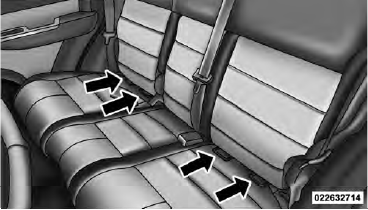 Latch Anchorages
Latch Anchorages
In addition, there are tether strap anchorages behind each rear seating position located on the back of the seat.
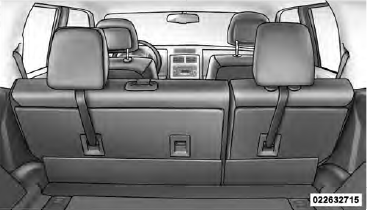 Tether Strap Mounting
Tether Strap Mounting
Many, but not all restraint systems will be equipped with separate straps on each side, with each having a hook or connector for attachment to the lower anchorage and a means of adjusting the tension in the strap. Forwardfacing toddler restraints and some rear-facing infant restraints will also be equipped with a tether strap, a hook for attachment to the tether strap anchorage and a means of adjusting the tension of the strap. You will first loosen the adjusters on the lower straps and on the tether strap so that you can more easily attach the hooks or connectors to the vehicle anchorages. Next, attach the lower hooks or connectors over the top of the anchorage bars, pushing aside the seat cover material. Then, locate the tether anchorage directly behind the seat where you are placing the child restraint and attach the tether strap to the anchorage, being careful to route the tether strap to provide the most direct path between the anchor and the child restraint. For the outboard seating positions, route the tether underneath the head rest and attach the hook to the tether anchor located on the back of the seat. Finally, tighten all three straps as you push the child restraint rearward and downward into the seat, removing slack in the straps according to the child restraint manufacturer’s instructions.
WARNING: Improper installation of a child restraint to the LATCH anchorages can lead to failure of an infant or child restraint. The child could be badly injured or killed. Follow the manufacturer’s directions exactly when installing an infant or child restraint.
Installing Child Restraints Using the Vehicle Seat Belt
The passenger seat belts are equipped with either cinching latch plates or automatic locking retractors, which are designed to keep the lap portion tight around the child restraint so that it is not necessary to use a locking clip. If the seat belt has a cinching latch plate, pulling up on the shoulder portion of the lap/shoulder belt will tighten the belt. However, any seat belt system may loosen with time, so check the belt occasionally and pull it tight if necessary. Pull the belt from the retractor until there is enough to allow it to pass through the child restraint and slide the latch plate into the buckle. Then, pull the belt until it is completely extracted from the retractor. Allow the belt to return to the retractor, pulling on the excess webbing to tighten the lap portion around the child restraint. Refer to “Automatic Locking Mode”. In the rear seat, you may have trouble tightening the lap/shoulder belt on the child restraint because the buckle or latch plate is too close to the belt path opening on the restraint. Disconnect the latch plate from the buckle and twist the short buckle-end belt several times to shorten it. Insert the latch plate into the buckle with the release button facing out. If the belt still can’t be tightened, or if pulling and pushing on the restraint loosens the belt, you may need to do something more. Disconnect the latch plate from the buckle, turn the buckle around, and insert the latch plate into the buckle again. If you still can’t make the child restraint secure, try a different seating position. To attach a child restraint tether strap: Route the tether strap over the seatback and attach the hook to the tether anchor located on the back of the seat. For the outboard seating positions, route the tether under the head rests, and attach the hook to the te
 Liftgate
Liftgate
To open the liftgate, pull up (squeeze) on the handle and
lift. Manually unlocking the vehicle doors with the
plunger or a key in the lock cylinder will not unlock the
liftgate.
Liftgate Rel ...
 Engine break-in recommendations
Engine break-in recommendations
A long break-in period is not required for the engine and
drivetrain (transmission and axle) in your vehicle.
Drive moderately during the first 300 miles (500 km).
After the initial 60 miles (10 ...
See also:
Behavior with key lock-in prevention function non-operational
- If the lock lever is turned to the rear
(“LOCK”) position with the driver’s door
open and the driver’s door is then closed
with the lock lever in that position, the
driver’s door i ...
Owner’s Maintenance Checks
You should check the following
items at the specified intervals. If
you are unsure of how to perform
any check, turn to the appropriate
page listed.
Engine oil level - Check every
time you ...
Roof racks
A loaded roof rack can reduce
the
stability of the vehicle, particularly
when cornering and during cross
winds.
Driving off road with a loaded roof
rack is not recommended.
Fit only a roof ra ...
